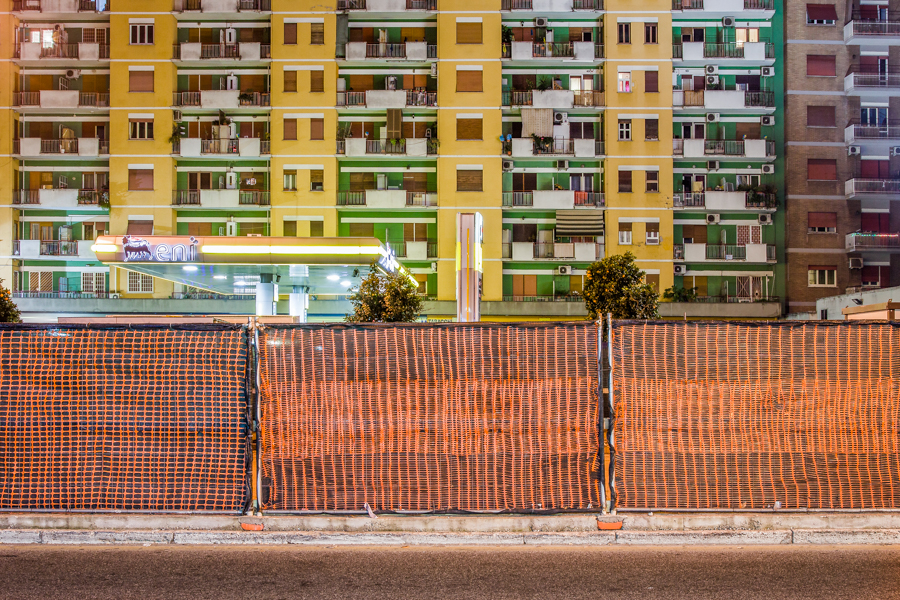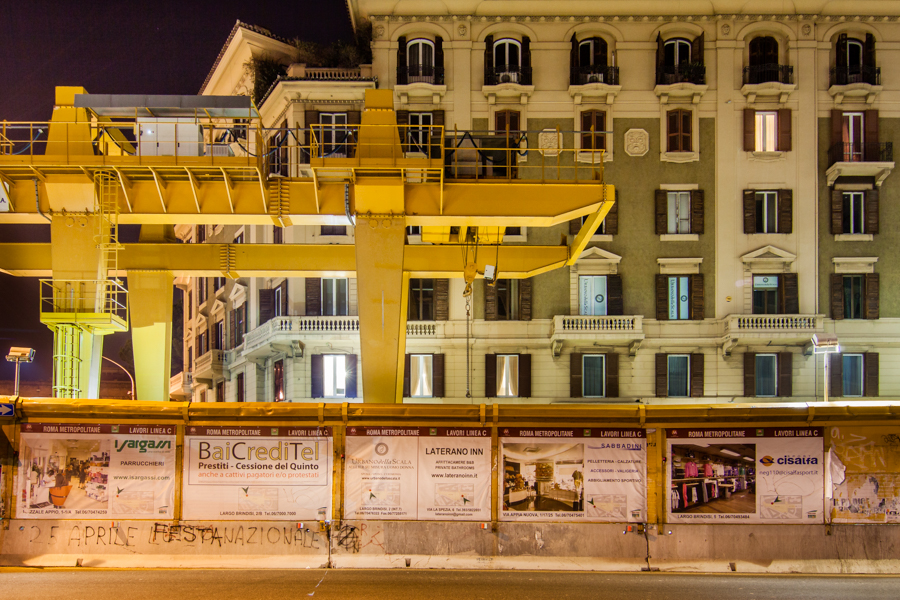ROMA SOTTO ASSEDIO
Le sanguinarie ferite di una città paradossale
testo di Sebastian Di Guardo
SDG – Perchè hai scelto come tema del tuo lavoro i cantieri, le cesure urbane?
VL – È stata una scelta dettata dal luogo dove abitavo quando cercavo l’idea per il progetto fotografico: Re di Roma. Si potrebbe dire che il tema si quasi è imposto da sé, vicino casa stavano costruendo un parcheggio interrato mentre la zona limitrofa di S. Giovanni era in buona parte occupata, come tutt’ora, dai cantieri della Metro C . Le talpe e i vari macchinari di scavo e sollevamento di tutti quei cantieri mi sembravano, soprattutto di notte, delle macchine d’assedio medievali.
SDG – Ti sentivi “assediato”?
VL – Era una sensazione comune nel quartiere, forse proprio a causa di quei macchinari alieni, il cui scopo e funzionamento per chi non è del settore è in buona parte sconosciuto.
A Roma ci sono molti cantieri aperti, che si distinguono per materiale e colore delle barriere con cui sono delimitati, dal giallo della Metro al grigio del cantiere della Nuvola passando per il rosso degli ex-mercati generali, recinzioni, barriere e impalcature sono comuni denominatori di tutti i cantieri.
SDG – Cercavi un tema inconsueto?
VL – Più che altro cercavo un punto di vista inconsueto, non credo sia la prima volta che qualcuno fotografa i cantieri di Roma e chi ci vive conosce molto il problema dei lavori in corso ad oltranza, quello che ho provato a fare è stato evitare di raccontare il degrado e il malessere generati da quelle presenze ingombranti in maniera troppo diretta; privilegiando gli aspetti paradossali e surreali che ne derivano, nel silenzio della notte, col traffico ridotto al minimo, i cantieri illuminati mi sembravano quasi entità con una propria identità estetica, presenze piu’ simili a delle opere di Land Art che criticità difficilmente sostenibili per chi ci vive vicino.
SDG – Quindi a Roma questo “’assedio” trovi sia diverso rispetto ad un altro posto? che faccia parte della “Grande bellezza” di questa città?
VL – Non si può negare che i cantieri “eterni” siano una caratteristica peculiare italiana e soprattutto romana considerando che, accanto ai vari problemi di tipo politico e burocratico, la complessità geologica ed archeologica del sottosuolo della capitale non aiuta. Quanto all’aspetto surreale notturno sicuramente è un elemento comune a tutte le città, mi vengono in mente i cantieri di Porta Nuova a Milano per esempio, ma certamente ci sono luoghi dove questo aspetto diventa ancora piu’ accentuato: penso alla Cina fotografata da Peter Bialobrzeski oppure al lavoro su Shangai di Greg Girard, pubblicato con la prefazione di William Gibson, in cui l’immagine fotografica della città che ne deriva ricorda piu’ quella di un romanzo cyberpunk o di un film di fantascienza.
SDG – Ho notato alcune scelte da parte tua, come la totale assenza di persone e il fatto che tutte le foto sono fatte di notte. Perché queste scelte?
VL – Di notte ogni tipologia di luce ha una propria temperatura colore, differenze che l’occhio tende a uniformare ma che la fotografia evidenzia, trasfigurando la realtà che normalmente conosciamo, inoltre la Roma notturna mi ricorda diverse suggestioni cinematografiche, penso a Fellini ma anche a Garrone. Trovo che anche di notte a Roma sia difficile sentirsi soli, la presenza umana si percepisce costantemente anche quando non è manifesta anche se chiaramente mi riferisco ai quartieri con una forte identità storica. Difficile non sentirsi isolati nell’estrema periferia che non a caso tende a sembrare identica in tutte le città.
Continua a leggere
Assedio Website. by Vincenzo Labellarte Fotografia
ROME UNDER SIEGE
The bloody wounds of a paradoxical city
Text by Sebastian Di Guardo, translations by Laura Dumbrava
SDG – Why did you choose as theme of work the yards, the urban caesurae?
VL – It was a choice dictated by the place where I lived when I was searching the idea for the photographic project: Re di Roma. It could be said that the theme was almost imposed by itself. Nearby home, the constructors were building a basement parking while the neighboring area of S. Giovanni was widely occupied, as yet, by the C subway’s yards. The moles, the various excavations machines and the lifting of all those yards seemed to me, especially by night, medieval siege machines.
SDG – Did you feel yourself “besieged”?
VL – It was a common sensation in the neighborhood, maybe because of those alien machines which purpose and functionality for the people who are unaware of this field is mostly unknown. In Rome, there are many opened yards which distinguish themselves from material and barrier colour with which they are delimited, from the silver of the subway to the Nuvola yard passing by the red of the ex general markets, enclosures, barriers and scaffolds, these are common denominators of all yards.
SDG – Were you searching for an unusual theme?
VL – More than anything else I was searching for an unusual point of view, I do not think that it is the first time when someone snaps a picture of Rome’s yards and those who live there know well the problem of the works in progress till the end. What I wanted to try to do was to evitate to tell the deterioration and the malaise generated by those cumbersome presences in such a direct manner; by privileging the resulted paradoxal and surreals aspects, in the silence of the night, with the traffic reduced at minimum, the illuminated yards seemed to me almost an entity with an own esthetic identity, presences similar to Land Art pieces of art which the critical issues are unlikely for who lives nearby.
SDG – So, in Rome you find this “siege” different compared to another place? It is that part of the “Grande bellezza” of this city?
VL – It cannot be denied that the “eternal” yards are an Italian peculiar characteristic and mostly Roman by taking into consideration that next to the various political and bureaucratic problems, the geological and archeological complexity of the capital’s soil do not help. Regarding the surreal nocturnal aspect, it is surely a common element of all cities. It comes in my mind the yards of Porta Nuova, in Milan for instance, but certainly there are places where this aspect becomes more highlighted: I think of China photographed by Peter Bialobrzeski or of the work on Shanghai by Greg Girard, published with Wiliam Gibson’s preface in which the photographic image of the city recalls more a city of a cyberpunk novel or science fiction movie.
SDG – I have noticed some of your choices such as the total absence of persons and the fact that all the images had been taken by night. Why these choices?
VL – By night, each typology of light has its own colour temperature, differences which the human eye is inclined to fit but which the photo highlights by transfiguring the reality which normally we know. Furthermore, the nocturnal Rome reminds me different cinematographic suggestions; I think of Fellini but also of Garrone. I also find that by night, in Rome, it is difficult to feel alone, the human presence is constantly perceived even when it is not expressed even though I clearly refer to the neighborhoods with a strong historical identity. It is difficult not to feel isolated in the extreme suburbs which, not by chance, seem identical in all the cities.
Asedio Website. by Vincenzo Labellarte Photography


